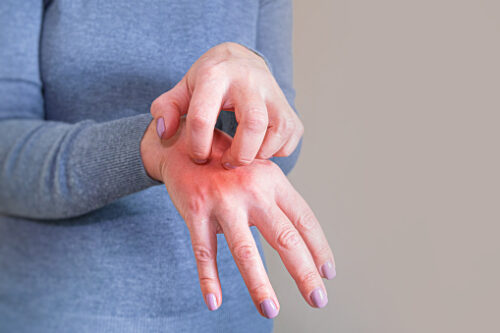The Sarcoptes scarbiei mite is the culprit behind scabies. These tiny mites can remain on your skin for months if left untreated. They procreate on the surface of your skin before tunneling underneath to lay eggs. Your skin develops an itchy, red rash as a result, which causes severe itchiness that cannot let you sleep in peace.
Scabies is very contagious, especially when people live together and lose contact. A practitioner should check and treat other family members at the same time if one family member has scabies. During this time of Floods there is a high chance of spread of these types of skin infection among the flood victims. If you are facing any symptoms related to scabies, you can consult the best dermatologists through Marham.pk.
What are the Symptoms of Scabies?

The symptoms of scabies may take two to five weeks to manifest after the initial exposure. Those who have already experienced scabies typically experience symptoms 1 to 4 days following exposure, sometimes even sooner.
The rash of scabies can appear on these parts of the body;
- Between the fingers and toes
- Armpits
- Between the knee joint
- Wrist
- Elbows
- Penis and scrotum
- Waist
- Buttocks
The rash has extreme itchiness that triggers, especially at night. The chances of superinfection with bacteria or fungus are greater when the continuous scratching of the rashes may lead to other infections.
What is the Cause of Scabies?
According to Marham an infestation of small, eight-legged mites acts as the causative agent for scabies. Although you can’t see these bugs on your skin because they are so minute, their impacts are noticeable and unpleasant.
To survive and eat, these mites tunnel into the top layer of your skin. Mite females produce eggs. When the mites and their excrement contact your skin, a red, itching rash appears.
Animals are not the source of these mites. Animals may contract a distinct type of scabies mite that results in “mange,” a condition in animals. So the scabies transmission is through human-to-human contact. Or with the exposure to clothing, bedding, furniture, etc. used by the patient having scabies.
What are the Types of Scabies?
The causative agent of scabies is same in all different types of scabies. But the infection type is different as the infestation style of these mites is different. Here are the common types of scabies caused by the Sarcoptes scabiei mites;
Nodular Scabies:
As the name suggests, this variety of scabies can manifest as itchy, raised bumps or lumps, particularly in the armpits, groin, or genitals.
Typical Scabies:
The majority of infestations caused by these mites are like this. The itchy rash appears on the hands, wrists, and other common areas. It does not, however, infest your face or scalp.
Crusted Scabies:
A more serious and highly contagious form of scabies is crusted scabies. People who have crusted scabies develop thick skin crusts containing a large number of mites and their eggs. Its other name is Norwegian scabies. People with low immune systems are more prone to this type of scabies.
How to Diagnose Scabies?
Scabies can frequently be identified by physical examination at your doctor’s clinic and visual inspection of the skin area that is affected. In some circumstances, your top skin specialist may perform a test by using a needle to extract a mite from your skin in order to confirm the diagnosis.
A microscopic examination is also performed to diagnose the scabies by confirming the presence of mites in the sample taken from the skin of the patient.
What is the Treatment for Scabies?
The most common method of treating scabies is to use topical prescription creams, lotions, and ointments to eradicate the infestation. There are other oral medicines available for the treatment of scabies.
These are the common topical medications that are used to treat scabies by killing the mites;
- 5 percent permethrin cream
- 25 percent benzyl benzoate lotion
- 10 percent sulfur ointment
- 10 percent crotamiton cream
- 1 percent Lindane Lotion
Apart from these medicines, antihistamines, antibiotics are also prescribed according to the condition of patient to treat the pain, swelling, and itchiness.
Who are at High Risk of Getting Scabies?
Scabies can affect anyone. Poor hygiene is not the source of this sickness. Scabies is more likely to affect certain people, such as;
- People who reside in cramped, crowded places.
- children and babies. Children frequently come in close proximity to their parents, friends, family, and classmates, so they are at high risk of getting scabies.
- The elderly, particularly those residing in nursing facilities, rehabilitation centers, etc.
- Healthcare professionals who provide care to patients who are unaware they have scabies.
Although scabies is a treatable skin condition, it may get worsen if left untreated. It leads to serious health conditions like septicemia, or severe bacterial infections in the rashes that may lead to heart complications or kidney failure.
If you are seeking treatment for scabies, you can consult the best dermatologists through Marham.